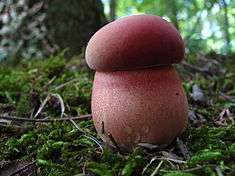Boletus sensibilis
Boletus sensibilis is a species of fungus in the family Boletaceae. The species was first described scientifically by American mycologist Charles Horton Peck in 1879.[1] This species is very similar to two other red boletes, Baorangia bicolor and Boletus pseudosensibilis.
| Boletus sensibilis | |
|---|---|
 | |
| Young fruit body | |
| Scientific classification | |
| Kingdom: | |
| Division: | |
| Class: | |
| Order: | |
| Family: | |
| Genus: | |
| Species: | B. sensibilis |
| Binomial name | |
| Boletus sensibilis | |
| Boletus sensibilis | |
|---|---|
float | |
| pores on hymenium | |
| cap is convex | |
| hymenium is adnate | |
| stipe is bare | |
| spore print is olive-brown | |
| ecology is mycorrhizal | |
| edibility: poisonous | |
Description
This vibrant mushroom has a stem around 5–13 cm long, and 2–3.5 cm thick. The stem has a classic club shape. Perhaps the most characteristic of this mushroom is its near instantaneous blue staining when handled, which led to the Latin "sensitive" in its name. Some describe the smell of the mushroom as a "curry-like" odor, although descriptions of this smell vary. The mushroom is mycorrhizal with hardwoods, and can often be seen growing near oaks or beech in the fall and summer east of the Rocky Mountains.[2]
References
- Peck CH. (1879). "Report of the Botanist". Annual Report on the New York State Museum of Natural History (32): 33.
- "Boletus sensibilis Kuo". Index MushroomExpert. CAB International. Retrieved 2019-02-25.